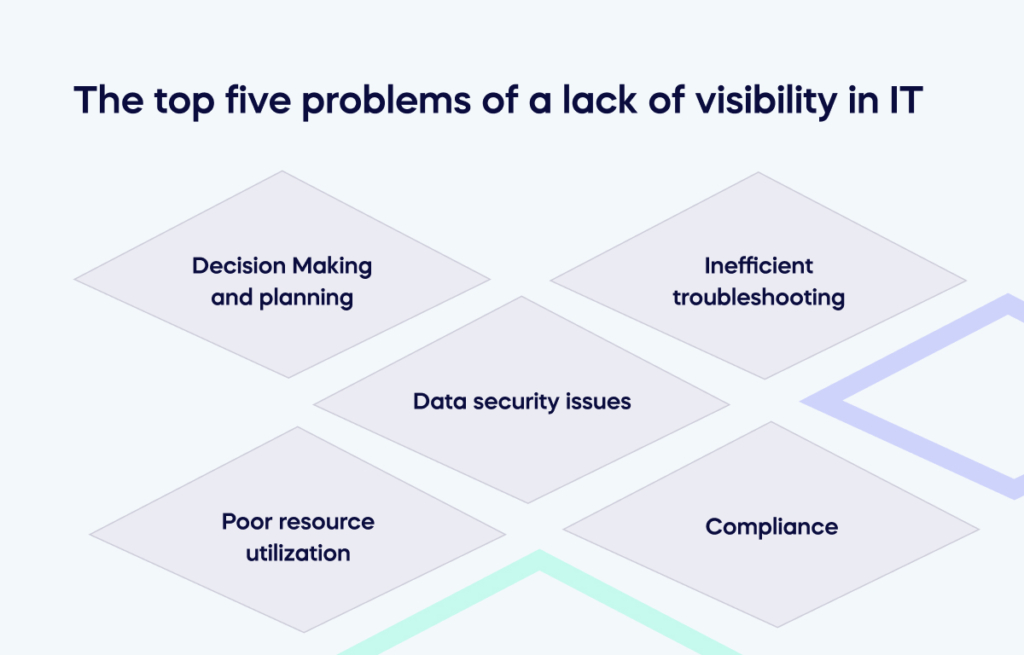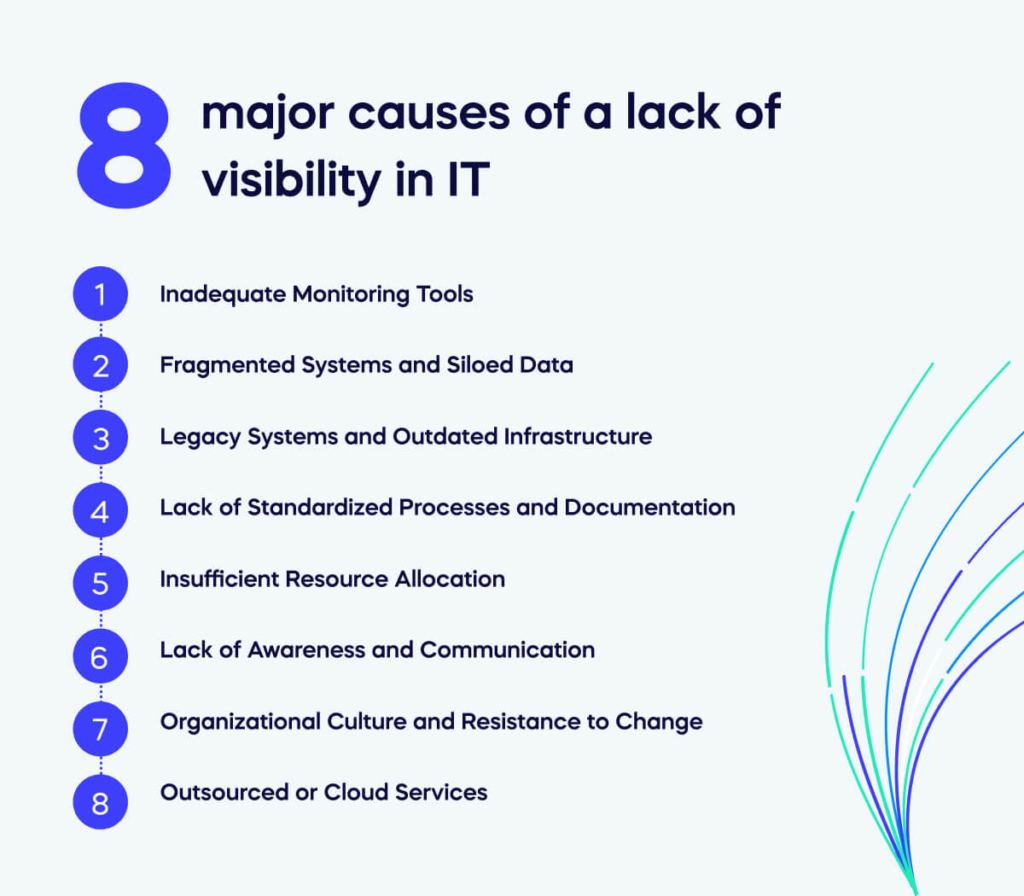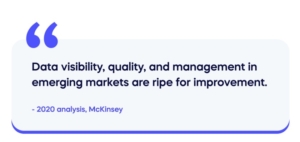Visibility, transparency, and openness are great principles for running any business.
But complete visibility is very hard to achieve when it comes to complex processes like change management, supply chains, or IT. No one is trying to hide or conceal anything! Yet with all these sprawling systems of people, technology, processes, and more, it’s very difficult to keep track of everything.
This article will discuss the problems of a lack of IT visibility.
We’ll start by explaining what lack of visibility in IT means and how it differs from other types of business transparency. Then we will explain the top 5 impacts that a lack of visibility in IT hurts your business. Before we’re through, we’ll review the causes and solutions.
IT visibility is a tough nut to crack.
Why? For one reason, a single IT department has less and less direct oversight of the overall digital infrastructure within their organization. In one striking data point, Gartner research from March 2023 predicted that 75% of employees will introduce technology not in IT’s view by 2027. In such a situation, there’s a high risk of a lack of IT visibility. Before the problems get out of control, introduce measures to improve things now.
What is a lack of visibility in IT?
Businesses face a lack of visibility in IT when leadership has inadequate insight into their IT systems, infrastructure, processes, and performance.
There is a lack of comprehensive and real-time information and data about various aspects of the IT environment. This lack of visibility can manifest in different areas, including system performance, application performance, security detection, configuration management, resource utilization, and technological compliance.
A lack of visibility in IT hampers organizations’ ability to monitor, analyze, and optimize their IT infrastructure, systems, and processes. It can result in inefficiencies, increased risks, poor decision-making, and reduced overall performance and security. Establishing visibility is crucial for organizations to effectively manage and derive value from their IT investments.
Visibility and transparency are important across many aspects of corporate life. Complete transparency can lead to problems for human resources, as Ethan Bernstein demonstrated in a classic HBR article. By contrast, for IT resources, transparency is a consistently helpful tool.
The top five problems of a lack of visibility in IT

Here’s a funny thing. IT infrastructure with poor visibility might work ok. It gets the job done, and no one complains. So why bother thinking about it?
Poor visibility in IT creates many deep and lasting problems for your company. We’re going to take a whistle-stop tour of the top five. From decision-making to resource utilization, it’s worth thinking about each of these carefully.
Decision Making and planning
Without proper visibility into IT systems, decision-makers don’t have the information they need for well-informed choices. This can result in poor strategic planning, resource allocation, and investment decisions, leading to inefficiencies and wasted resources.
Inefficient troubleshooting
When problems occur, a lack of IT visibility makes it difficult to resolve issues. The organization must rely on time-consuming manual processes to identify the root of problems. This can lead to increased downtime and reduced productivity.
Data security issues
A lack of visibility makes it difficult to pick up on security issues. If you don’t know about the full range of your systems, it’s harder to detect and respond to security breaches, vulnerabilities, or suspicious activities. This increases the risk of data breaches, unauthorized access, and other cybersecurity incidents.
Poor resource utilization
Low IT visibility can lead to poor use of resources. Perhaps every business unit uses cloud storage on separate subscriptions, or there are many subscriptions to overlapping packages. This does not make sense financially. The full range of resource utilization, including software license management, can be dramatically improved as soon as you understand usage.
Compliance
Most industries have regulatory and compliance requirements that organizations must adhere to. Without visibility into IT systems, monitoring and ensuring compliance with these regulations becomes challenging. This can lead to legal and financial consequences and reputational damage.
Eight major causes of a lack of visibility in IT

No one plans to make their IT systems opaque. But there are several common problems that your organization might accidentally make, which lead to a lack of visibility in IT.
Here, we’ll look at eight of the most significant causes. If you’re facing a lack of visibility in IT, check this out: from inadequate monitoring tools to outsourced cloud services, we’ve got you covered.
Inadequate Monitoring Tools
One primary cause is the absence or insufficient use of monitoring tools and technologies. Organizations may lack the proper infrastructure or tools to collect and analyze data on IT systems, applications, network traffic, or security events, leading to a lack of visibility. If you’ve got no way to take an inventory of your assets and undertake constant monitoring, it’s no wonder you don’t know what’s happening!
Fragmented Systems and Siloed Data
In complex IT environments, different systems, applications, and departments may operate in isolation, resulting in fragmented data and limited visibility. A lack of integration between these systems and data silos can make obtaining a holistic view of the IT landscape difficult. In many organizations, this is becoming the norm, as each business unit relies on many pieces of specialist software.
Legacy Systems and Outdated Infrastructure
Legacy systems or outdated infrastructure may lack the necessary capabilities for visibility. Older systems may not support modern monitoring techniques, APIs, or protocols, making gathering real-time data and insights challenging.
Lack of Standardized Processes and Documentation
Inconsistent or poorly documented processes can hinder visibility. When IT processes are standardized and well-documented, tracking and understanding system configurations, changes, and dependencies becomes easier, leading to a lack of visibility into the overall IT environment.
Insufficient Resource Allocation
Limited resources, including budget and personnel, can impede efforts to establish visibility. Organizations may not allocate sufficient resources to implement and maintain monitoring tools, conduct regular audits, or invest in training and skill development related to visibility.
Lack of Awareness and Communication
Sometimes, the lack of visibility stems from a lack of awareness or understanding of its importance. If stakeholders, including management, are not fully aware of the benefits of visibility or fail to communicate its significance, it can result in a lower priority for visibility initiatives.
Organizational Culture and Resistance to Change
In some cases, the organizational culture may resist changes related to visibility. Resistance to adopting new tools, processes, or approaches can limit the organization’s ability to establish comprehensive visibility across the IT landscape.
Outsourced or Cloud Services
Organizations relying on outsourced or cloud-based services may have limited visibility into the underlying infrastructure and operations. Service-level agreements (SLAs) and contractual limitations can restrict access to monitoring data and insights, reducing visibility.
The solutions for lack of visibility in IT
The bigger your organization, the harder it will be to solve a lack of IT visibility. However, three quick ways can support the rapid growth of transparency: Digital adoption platforms, a digital scorecard, and cultural change. We will look at each of these in turn.
Implement monitoring systems. If you have a complex software, hardware, and data environment, you might not want to use even more software. However, a suitable monitoring system like a digital adoption platform can distinguish between success and failure.
Get a comprehensive view from a digital experience scorecard. A digital experience score can improve IT visibility and transparency by providing extensive data collection, real-time monitoring, and user-centric insights. It enables organizations to identify performance issues, analyze root causes, and make data-driven decisions. By benchmarking against industry standards and setting goals, organizations can prioritize improvements, enhance user experience, and foster transparent communication between IT teams and stakeholders, ultimately improving visibility into IT operations.
Finally, a workplace cultural transformation can support IT visibility. Ideally, your organization will have a culture of collaboration and communication between teams. With knowledge sharing, cross-functional understanding, and efficient issue resolution, teams can understand how their use of IT can be aligned. A collaborative approach may be difficult to achieve. But it can foster transparency, reduces silos, and enhances the organization’s ability to proactively monitor and optimize IT performance.
IT visibility: the best response to digital sprawl
Research has clearly explained how visibility in IT can dramatically improve organizational outcomes. For example, in a 2020 analysis, McKinsey found that “Data visibility, quality, and management in emerging markets are ripe for improvement.” Simple improvements in the healthcare system mean leaps forward for decision-making and delivery of the most time-sensitive products.

This article shows how a lack of IT visibility can arise from today’s sprawling ecosystems. The lack of visibility creates many problems, ultimately harming business outcomes. There are no easy answers – but there are solutions that will improve transparency. Digital adoption platforms, cultural change, and digital scorecards can all make a positive change.
Some of us remember the days when the software was straightforward and predictable. Those days are long gone. In 2023, you need to get a handle on your IT visibility before your IT systems get out of hand.

